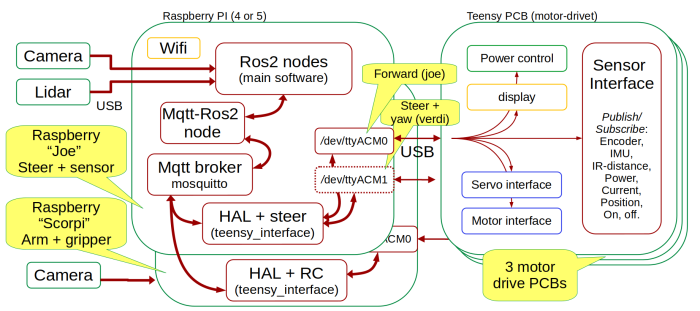Scorpi modules: Difference between revisions
No edit summary |
|||
| Line 11: | Line 11: | ||
[[file:scorpi-processor-software-blocks.png | 700px]] | [[file:scorpi-processor-software-blocks.png | 700px]] | ||
The Scorpi system has two Raspberry Pi processors (version 4 and 5) and three hardware interface boards (Teensy motor drive boards). | |||
The main functionality for autonomous operation is handled in the ROS2 nodes. | |||
Camera and Lidar interface directly to ROS2 using ROS drivers. | |||
All other sensors and actuators are interfaced through a ROS-MQTT node. | |||
There is one MQTT broker only. | |||
MQTT messages are generated by the hardware abstraction layer (HAL) in a Teensy_interface application. | |||
Both Raspberry Pi processors run a teenst_interface, sending data to the same MQTT message broker. | |||
The teensy_interface uses USB to talk to one or two processor boards with a Teensy 4.1 processor. The Teensy software is called motor_drive. Each board includes four motor drivers, an interface to three angle encoders, two MPUs, and other items. | |||
The board also delivers power to the Raspberry Pi and handles the power on and off. | |||
== Drive control == | == Drive control == | ||
Revision as of 08:49, 11 August 2024
Back to Scorpi
Overview of hardware interface
This overview is focused on the hardware and hardware interface modules used as the basis for controlling the Scorpi system.
The described software module relates to the source code file where the module is implemented.
Processor boards
The Scorpi system has two Raspberry Pi processors (version 4 and 5) and three hardware interface boards (Teensy motor drive boards).
The main functionality for autonomous operation is handled in the ROS2 nodes.
Camera and Lidar interface directly to ROS2 using ROS drivers.
All other sensors and actuators are interfaced through a ROS-MQTT node. There is one MQTT broker only.
MQTT messages are generated by the hardware abstraction layer (HAL) in a Teensy_interface application. Both Raspberry Pi processors run a teenst_interface, sending data to the same MQTT message broker.
The teensy_interface uses USB to talk to one or two processor boards with a Teensy 4.1 processor. The Teensy software is called motor_drive. Each board includes four motor drivers, an interface to three angle encoders, two MPUs, and other items. The board also delivers power to the Raspberry Pi and handles the power on and off.
